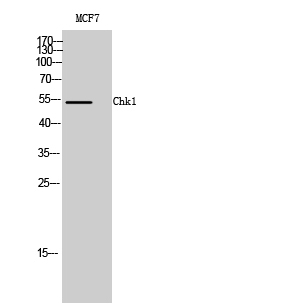Total Chk1 Cell-Based Colorimetric ELISA Kit
- Catalog No.:KA3071C
- Applications:ELISA
- Reactivity:Human;Mouse;Rat
- Gene Name:
- CHK1
- Human Gene Id:
- 1111
- Human Swiss Prot No:
- O14757
- Mouse Swiss Prot No:
- O35280
- Rat Swiss Prot No:
- Q91ZN7
- Storage Stability:
- 2-8°C/6 months
- Other Name:
- Serine/threonine-protein kinase Chk1 (EC 2.7.11.1) (CHK1 checkpoint homolog) (Cell cycle checkpoint kinase) (Checkpoint kinase-1)
- Detection Method:
- Colorimetric
- Background:
- catalytic activity:ATP + a protein = ADP + a phosphoprotein.,domain:The autoinhibitory region (AIR) inhibits the activity of the kinase domain.,function:Required for checkpoint mediated cell cycle arrest in response to DNA damage or the presence of unreplicated DNA. May also negatively regulate cell cycle progression during unperturbed cell cycles. Recognizes the substrate consensus sequence [R-X-X-S/T]. Binds to and phosphorylates CDC25A, CDC25B and CDC25C. Phosphorylation of CDC25A at 'Ser-178' and 'Thr-507' and phosphorylation of CDC25C at 'Ser-216' creates binding sites for 14-3-3 proteins which inhibit CDC25A and CDC25C. Phosphorylation of CDC25A at 'Ser-76', 'Ser-124', 'Ser-178', 'Ser-279' and 'Ser-293' promotes proteolysis of CDC25A. Inhibition of CDC25 activity leads to increased inhibitory tyrosine phosphorylation of CDK-cyclin complexes and blocks cell cycle progression. Binds to and phosphorylates RAD51 at 'Thr-309', which may enhance the association of RAD51 with chromatin and promote DNA repair by homologous recombination. Binds to and phosphorylates TLK1 at 'Ser-743', which prevents the TLK1-dependent phosphorylation of the chromatin assembly factor ASF1A. This may affect chromatin assembly during S phase or DNA repair. May also phosphorylate multiple sites within the C-terminus of TP53, which promotes activation of TP53 by acetylation and enhances suppression of cellular proliferation.,PTM:Phosphorylated by ATR in a RAD17-dependent manner in response to ultraviolet irradiation and inhibition of DNA replication. Phosphorylated by ATM in response to ionizing irradiation. ATM and ATR can both phosphorylate Ser-317 and Ser-345 and this results in enhanced kinase activity. Phosphorylation at Ser-345 also increases binding to 14-3-3 proteins and promotes nuclear retention. Conversely, dephosphorylation at Ser-345 by PPM1D may contribute to exit from checkpoint mediated cell cycle arrest. May also be phosphorylated at Ser-280 by AKT1/PKB, which may promote mono and/or diubiquitination. Also phosphorylated at undefined residues during mitotic arrest, which results in decreased activity.,PTM:Ubiquitinated. Mono or diubiquitination promotes nuclear exclusion.,similarity:Belongs to the protein kinase superfamily. CAMK Ser/Thr protein kinase family. NIM1 subfamily.,similarity:Contains 1 protein kinase domain.,subcellular location:Nuclear export is mediated at least in part by XPO1/CRM1. Also localizes to the centrosome specifically during interphase, where it may protect centrosomal CDC2 kinase from inappropriate activation by cytoplasmic CDC25B.,subunit:Interacts with BRCA1, CLSPN, PPM1D, RAD51, TIMELESS, XPO1/CRM1 and YWHAZ/14-3-3 zeta.,tissue specificity:Expressed ubiquitously with the most abundant expression in thymus, testis, small intestine and colon.,
- Function:
- cell cycle checkpoint, DNA damage checkpoint, regulation of cyclin-dependent protein kinase activity, G2/M transition of mitotic cell cycle, mitotic cell cycle, M phase, DNA metabolic process, DNA replication, DNA repair, DNA recombination,protein amino acid phosphorylation, phosphorus metabolic process, phosphate metabolic process, response to DNA damage stimulus, cell cycle, meiosis, meiosis I, reciprocal meiotic recombination, intracellular signaling cascade,gamete generation, negative regulation of cell proliferation, phosphorylation, regulation of phosphate metabolic process, sexual reproduction, cell cycle process, cell cycle phase, DNA integrity checkpoint, multicellular organism reproduction, cellular response to stress, regulation of cell proliferation, regulation of phosphorylation, DNA damage response, signal transduction, regulation of kinase activity, regulation of protein k
- Subcellular Location:
- Nucleus . Chromosome . Cytoplasm . Cytoplasm, cytoskeleton, microtubule organizing center, centrosome . Nuclear export is mediated at least in part by XPO1/CRM1 (PubMed:12676962). Also localizes to the centrosome specifically during interphase, where it may protect centrosomal CDC2 kinase from inappropriate activation by cytoplasmic CDC25B (PubMed:15311285). Proteolytic cleavage at the C-terminus by SPRTN promotes removal from chromatin (PubMed:31316063). .
- Expression:
- Expressed ubiquitously with the most abundant expression in thymus, testis, small intestine and colon.
- June 19-2018
- WESTERN IMMUNOBLOTTING PROTOCOL
- June 19-2018
- IMMUNOHISTOCHEMISTRY-PARAFFIN PROTOCOL
- June 19-2018
- IMMUNOFLUORESCENCE PROTOCOL
- September 08-2020
- FLOW-CYTOMEYRT-PROTOCOL
- May 20-2022
- Cell-Based ELISA│解您多样本WB检测之困扰
- July 13-2018
- CELL-BASED-ELISA-PROTOCOL-FOR-ACETYL-PROTEIN
- July 13-2018
- CELL-BASED-ELISA-PROTOCOL-FOR-PHOSPHO-PROTEIN
- July 13-2018
- Antibody-FAQs


